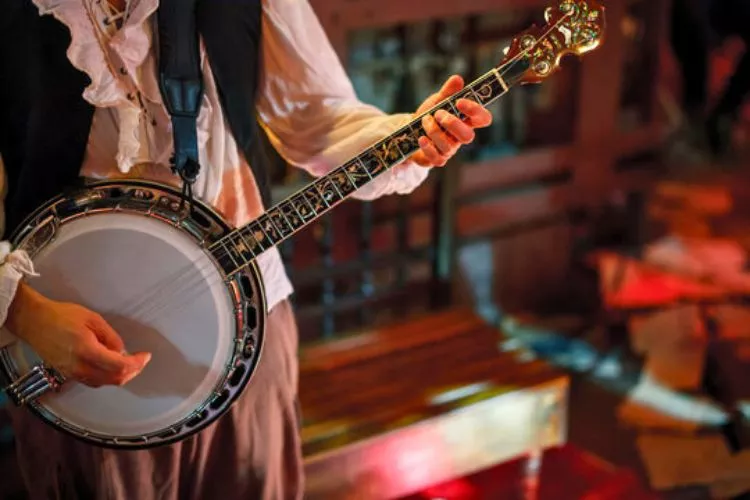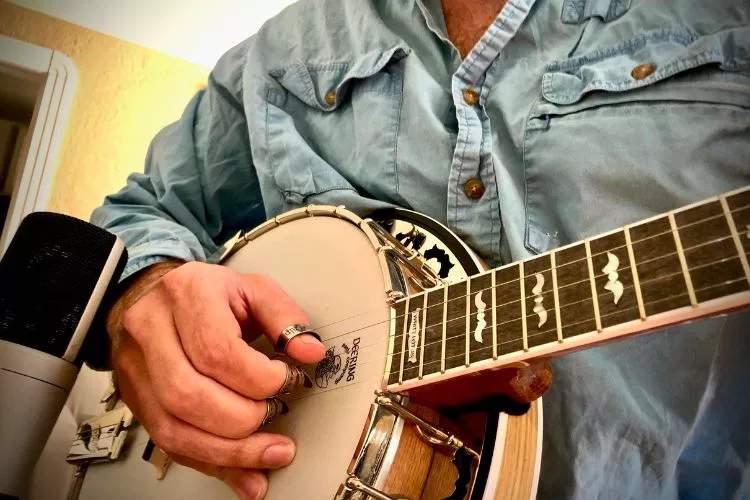Setting up a banjo is an essential skill all players should know. It ensures optimal sound quality, playability, and longevity of the instrument. This article will guide you through the process of setting up a banjo, covering key areas such as adjusting the bridge, setting string action, and tuning the instrument.

Whether you’re a beginner or a seasoned banjo player looking to fine-tune your setup process, this comprehensive guide will equip you with the necessary knowledge to maintain your banjo at its best
Contents
🎶How to set up a banjo?
Setting up a banjo involves several key stages: assembly, bridge placement, head tensioning, string action adjustment, and tuning. Let’s go through each stage one by one:

1. Assembly
If your banjo arrives disassembled, use the manufacturer’s instructions to put together your instrument. This usually involves attaching the neck, tailpiece, and strings, and occasionally the banjo head (the drum).
2. Bridge Placement
The bridge is not fixed on a banjo and needs to be correctly positioned. For accurate placement:
- Measure Twice: Use a measuring tape to exact scale length, traditionally twice the distance from the top of the nut to the 12th fret. Mark this length from the top nut to the approximate middle of the banjo’s head.
- Position the Bridge: Stand the bridge up on the marked spot under the strings, gently positioning it to be perpendicular to the strings.
- Adjust Slowly: Banjo bridges can easily fall, so adjust gradually while maintaining tension on the strings.
3. Head Tensioning
Banjo head’s tension affects the instrument’s tone. If the head is too loose, it could yield a dull, low-pitched sound. Similarly, if it’s too tight, the sound may become overly bright.
- Initial Adjustment: Start by softly tapping the banjo head near the tension hoop with your finger or a drumstick to hear the sound.
- Incremental Tightening: Using a drum dial or a banjo wrench, slightly tighten all nuts in a star pattern to evenly distribute the tension.
- Final Checking: Tap the head again to judge the sound and make necessary adjustments.
4. String Action Adjustment
For comfortable playing, the action (distance between fretboard and strings) should be correct:
- Assess Distance: The strings should be high enough away from the frets to prevent buzzing but low enough for easy fretting.
- Adjust Truss Rod: If the distance is incorrect, adjust the rod in the neck to increase or decrease the curvature.
5. Tuning
Finally, tune the banjo so it’s ready to play! If you have a 5-string banjo, the common tuning is gDGBD. Remember to be patient and systematic with these steps, as correctly setting up your banjo is key to enjoyable playing and can help prolong the life of your instrument.
🎶How Do You Set Up a Banjo Bridge?
The bridge of your banjo is critical for sound transmission and is also responsible for intonation. Here’s how you can set up your banjo bridge:
- Locate the Correct Position: The appropriate place for the bridge is at a location where the length of the vibrating part of the strings is exactly twice the distance from the inside edge of the nut to the 12th fret.
- Adjust the Bridge: Move the bridge to this location. Do this carefully, as you don’t want to scratch the head of the banjo.
- Fine-tune: Play each string at the 12th fret and then at the harmonic (lightly touch the string at the same fret and pluck). They should produce the same note. If they don’t, adjust the bridge slightly and try again.
🎶How Do You Set Up an Action on a Banjo?
Setting up the action on a banjo refers to adjusting the distance between the fretboard and the strings. Here’s how it can be done:
- Measure the Action: Use a ruler to measure the distance between the top of the 12th fret and the bottom of the strings.
- Adjust the Neck: If the action is too high, tighten the truss rod to straighten the neck and bring the strings closer to the frets. If the action is too low (causing buzzing when you play), loosen the truss rod to create more relief in the neck.
- Modify the Bridge: You can further adjust the action by replacing the bridge with a higher or lower one.
🎶How Do You Tune a Banjo for the First Time?
Tuning a banjo properly helps to produce the best possible sound. Here’s the procedure for tuning a 5-string banjo for the first time:

- Seed Note: First, you need to tune your 1st string (the bottom one when you are holding the banjo) – you can get the right note, D, from a tuning fork, piano, or electronic tuner.
- Tuning by Ear: The 2nd string should be tuned to the same note as the 1st string when fretted at the 3rd fret. The 3rd string should be the same pitch as the open 1st string. The 4th string should be the same tone as the 1st string when fretted at the 5th fret. The 5th string, or drone string, should be the same note as the 1st string fretted at the 5th fret.
- Adjust the Strings: If you’re having difficulty tuning by ear, use a chromatic tuner. The standard tuning is gDGBD for a 5-string banjo.
- Fine-tune: Keep adjusting until you’re satisfied with the tuning.
Remember that frequent practice tuning and setting up your banjo will improve not just your sound, but also your ear and overall musicianship.
You may find useful: Can You Tune A Banjo With a Guitar Tuner?
🎶Frequently Asked Questions (FAQs)
The bridge should be placed on a banjo at a location where the length of the vibrating part of the strings is exactly twice the distance from the nut to the 12th fret. This is known as the scale length. To locate this position, measure the distance from the inside edge of the nut to the 12th fret, then double that measurement. Place the bridge at this doubled distance away from the nut on the center of the banjo’s head to achieve optimal intonation.
The best height for a banjo bridge depends on the individual player’s preference. Ultimately, it should provide a comfortable action—the distance between the strings and the frets—without resulting in buzzing or sacrificing playability. A higher bridge will result in a higher action, while a lower bridge will lead to a lower action. Beginners often prefer a lower action for comfort and ease. Typically, banjo bridges are available in heights ranging from ½ inch to ⅞ inch, allowing players to find the best fit.
A banjo bridge should be straight where it contacts the head, but it may have a slight curved or slanted top edge to accommodate different string heights. The feet of the bridge must have full contact with the banjo head for proper sound transmission. It’s essential for the bridge to be perpendicular to the strings and parallel to the nut, ensuring accurate intonation while playing. The slanted or curved top edge of the bridge allows for individual string height adjustments if necessary, catering to different playing styles.
The standard spacing for a banjo bridge refers to the distance between each string on the bridge. For a typical 5-string banjo, standard bridge spacing is approximately 1⅝ inches (41.27 mm) from the 1st to the 4th strings. This measurement can vary slightly depending on the banjo and player preferences, with some opting for wider or closer spacing depending on their playing style. Customizing bridge spacing can improve overall playability, so it’s essential to find the spacing that suits you best.
The bridge spacing for a 5-string banjo is often around 1⅝ inches (41.27 mm) from the 1st to the 4th strings. However, this may vary depending on personal preferences and the specific make of the banjo. Some players choose a wider or closer spacing configuration depending on their playing technique and comfort. The 5th string (drone string) is shorter with an individual position on the bridge, separate from the other four strings, which does not impact the overall spacing between strings 1 to 4.
Conclusion:
Learning how to set up a banjo correctly is vital to its sound, playability, and longevity as a musical instrument. Whether you’re assembling the parts, placing the bridge, adjusting the head tension, setting up the string action, or tuning it for the first time, each step requires patience, precision, and care. R
Remember, your banjo is a manifestation of your musical journey. By understanding and maintaining it well, you’ll not only enjoy a better-sounding instrument, but also enhance your overall musicianship, creating a richer, more rewarding musical experience.
